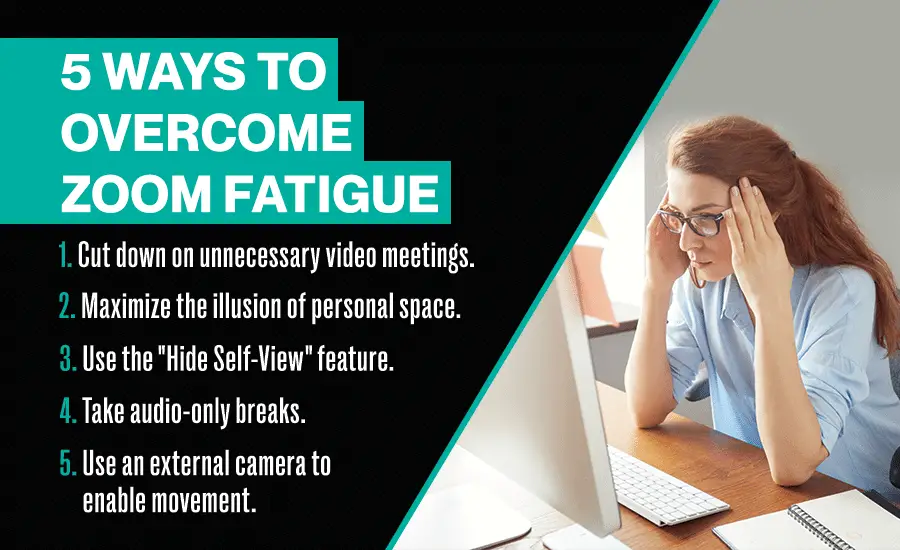Being a remote worker has its advantages: working from other countries, doing laundry in between meetings, saving money on gas, and more. However, according to McKinsey & Company, almost 60 percent of America’s workforce has transitioned to a work-from-home model in some capacity. With this, new problems no one could anticipate are arising.
Video platforms like Zoom, Microsoft Teams, and Google Meet have become necessary daily tools for teams located across the country. According to Matthew Woodward’s Zoom User Statistics, Zoom has grown by 2,900% since the pandemic, increasing its revenue by 326% year-over-year. In 2020 alone, the Zoom mobile app was downloaded 485 million times.
With video calls now being companies’ primary method of communication, a new concern is rising: Zoom fatigue. This phenomenon causes mental exhaustion, feelings of burnout, and lower levels of productivity. Additionally, a study by SSRN shows women are more at risk of developing it.
To avoid Zoom fatigue from negatively impacting your work, find out more about what it is and how to protect yourself from it.
What Is Zoom Fatigue?
Zoom fatigue is a feeling of tiredness that often occurs after a video call. It can make remote workers feel sluggish and demotivated without a clear reason. A person might experience tired eyes, lack of concentration, mental fatigue, and other symptoms commonly associated with exhaustion.
Symptoms of Meeting Fatigue
- Feeling mentally and physically depleted by the end of the work day.
- Dreading the next video call, no matter what it’s for.
- Not being able to concentrate during or after calls.
- Noticing your energy depleting after each meeting.
- Desiring isolation afterward.
- Experiencing unusual sweating or headaches during the call.
4 Causes of Zoom Fatigue
Fortunately, researchers have uncovered some of the most significant catalysts for this new fatigue, and a few simple adjustments can help mitigate it altogether. Founding director of the Stanford Virtual Human Interaction Lab (VHIL) Jeremy Bailenson explores the zoom fatigue phenomenon in “Nonverbal Overload: A Theoretical Argument for the Causes of Zoom Fatigue.” In it, he proposes four catalysts for the unique “psychological consequences” resulting from long or too-frequent virtual meetings.
1. Excessive and unnatural eye contact
“[A]ssuming all listeners are always looking at the speaker in the conference room, the amount of eye gaze on Zoom is eight times higher,” Bailenson says. Normally, seeing someone close-up and holding eye contact with them is a behavior reserved for personal relationships. During work video chats, however, we’re forced to maintain “eye gaze” and close-up views with coworkers and people we may not know. This unnatural interaction conflicts with our need for interpersonal space and can be exhausting.
2. Increased cognitive load
When in a physical room with others, sending and receiving nonverbal cues is a seamless, thoughtless occurrence. In a virtual meeting, however, these cues tend to be a little more challenging to perceive. Therefore, we become more conscious of our responses and expressions. For example, we make sure we’re making eye contact with the webcam lens and nod dramatically to display agreement. We also watch ourselves to make sure we’re not accidentally giving the wrong cues. The problem here is that having to monitor all of these nonverbal cues increases our cognitive load.
3. Constant self-evaluation
If we’re meeting with others in person, we’re not holding up a mirror and watching ourselves as we do. Yet, on Zoom, that’s exactly what the small self-view camera prompts us to do. Think about it—the last Zoom call you were on, how often did you look at yourself? Probably quite a few times. It seems minor, but constant self-evaluation contributes to feelings of fatigue and even negative thinking, increasing anxiety and cognitive load.
4. Restricted mobility
Unless you have an external camera that can automatically follow your movement, you’re probably pretty stationary during the duration of a video call. Of course, walking around is typically discouraged during in-person meetings, but there’s a big difference between the two regarding mobility. In a video call, you have a few inches in front of your camera so that your face is clear, and you must also stay centered to make “eye contact.” You can move around a little, but you’re generally working within that few-inch radius of your device. This can make you feel “stuck” and tethered to your computer, contributing to post-call Zoom burnout.

Who Does Zoom Fatigue Affect the Most?
A report by ScienceAlert found that Zoom fatigue particularly affects women. Of 10,322 people surveyed about video calls, 13.8% of the women reported feeling either “very” or “extremely” fatigued by Zoom calls. This is compared to only about 5.5% of men feeling equally affected.
In addition to these findings, a survey conducted by Stanford University, the University of Central Florida, and Michigan State University found that those with greater feelings of self-consciousness and dislike of their appearance experienced greater psychological exhaustion from video calls. Their survey showed that women’s Zoom fatigue was 14.9 percent higher than men’s.
5 Ways to Overcome Zoom Fatigue
If virtual meetings are a long-term part of your job, consider employing one or all of these strategies to optimize your time without compromising your energy.
1. Cut Down on Unnecessary Video Meetings
It’s easy to get swept into every meeting invitation that lands in your inbox, and these days, the pressure to accept is high. Before accepting meeting invitations, ask yourself these questions:
- “Is this a meeting I need to attend?”
- “Will my presence add value to the meeting?”
- “Is this a video call that can be a standard audio-only conference call?”
According to Hiya’s State of the Call 2022 report, regular phone calls are 27% more preferred than video calls. If video isn’t a crucial component, consider requesting a regular conference call instead.
2. Maximize the Illusion of Personal Space
You may be “stuck” within that few-inch camera radius, but there are some things you can do to help create the illusion of personal space within a digital realm:
- Reduce the size of your video call window from full screen.
- Limit the number of “grids” (faces) visible to you.
- Add an external keyboard to create additional space between you and your device.
Take this further by optimizing your physical workspace for maximum ergonomic comfort. The National Library of Medicine suggests that “the computer monitor should be placed only two feet from the face, and the top of the screen should be placed at eye level. In fact, an ergonomic work chair and an adjustable study desk, at minimum, provide an ideal height between the computer monitor and the viewer’s eye level.”
3. Use the “Hide Self-View” Feature
You wouldn’t be looking at yourself or checking your surroundings in an in-person environment, so eliminate the temptation to do so in a virtual one. You can do this by clicking the “hide self-view” feature within the settings of your video call platform.
As Stanford professor and researcher on the psychology of virtual and augmented reality Jeremy Bailenson describes, “It’s taxing on us. It’s stressful. And there’s a lot of research showing that there are negative emotional consequences to seeing yourself in a mirror.” While this is true, focusing on the positives can help you fight any toxic feelings you might have about yourself after a video call.
Three tips by Positive Psychology for combatting post-call negative thinking:
- Write down three to five things you’re grateful for in a gratitude journal.
- Spend 20 minutes writing down your vision of your best possible self.
- Practice mindfulness meditation to tune into how you are feeling without trying to change anything.
4. Take Audio-Only Breaks
Maintaining fixed eyesight on the camera and having so many fixed gazes towards you is a lot for your brain to process. Here are some tips for taking audio-only breaks:
- If video isn’t necessary in that moment, announce or state in a chat message that you’ll be turning off your camera briefly to practice active listening.
- Take moments to look away or physically distance yourself. This will give your brain a needed mental break.
- Examine any existing scheduled video calls and determine if they can be standard audio ones. If they can, switch them.
5. Use an External Camera to Enable Movement
Research shows that physical movement aids cognitive performance. Therefore, the physical space you create around your virtual meeting can make a big difference. To combat zoom fatigue and the feeling of “stuckness,” consider installing an external camera and positioning your device further back.
External cameras create space between you and the lens to take notes, doodle, eat a snack, sit, stand, stretch—everything you’d ordinarily do in person. It may sound counterintuitive, but creating this space to work and move freely during video calls will boost productivity when working from home.
Preventing Zoom Fatigue as an Employer
From increased social anxiety and cognitive load to negative self-talk and reduced mobility, the causes of Zoom fatigue can be as varied as the symptoms. As an employer or leader, it’s essential to keep these issues in mind and integrate other tactics to keep your team engaged.
Strengthen digital bonds by:
- Hosting occasional in-person meetings.
- Using technology to foster team camaraderie.
- Hiring talent with strong communication skills.
- Evaluating which meetings need video and which can be audio-only.
Continue exploring ways of strengthening your company in the digital era by reading “Building Remote Work Culture in 2022.”
